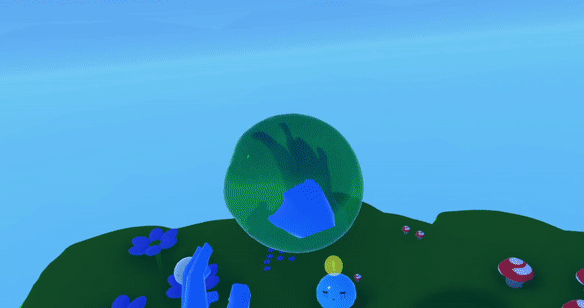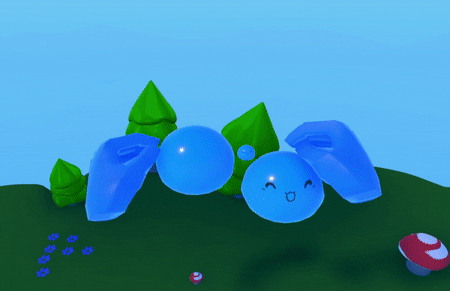Our week started by continuing to integrate the different elements of our game. The gestures were in a good state and it was time to develop a tutorial to teach the gestures. We tried out several different prototypes. Playtesting with our peers and feedback from our client helped us nail down a simple tutorial that we could realistically achieve in our time frame.

A pair of animated hands would play the gestures in front of the player at the start of the game to teach the gestures
We built out more environment pieces last week and started nailing down the final look of the game. For our final experience, we have planned out three islands with different rides on each of them. These, we decided, would be aesthetically separated based on seasons.

Fall Island 
Summer Island 
Winter Island
We iterated on the art of our rides to make them better fit the themeing of each island.
The sounds our creatures will make has also been an important topic. We were able to access the sound booth over here at EA and did some recordings for the creatures.
A major concern last week was how we make molding important to the gameplay. The reason why we were not able to achieve this so far is because we were limited by fluid properties that Nvidia Flex allowed us to manipulate. It was time to address this and after trying out a few more things, we found out that we can change the color and moldability of the fluid slime as the players interacted with it.

These were properties we believed we could leverage and decided that molding the fluid with different god powers will produce different types of slime.
We also started adding some of the interactions on our list. The major ones being stretching and combining. We have a basic prototype of “Stretch” interaction in the game but there are still a few kinks to fix before it feels satisfying. Our major challenge with ‘combine’ was to decide what kind of feedback should the action give. If the player tries to “put two slimes together” or combine them, should they merge and form a bigger slime? Should they resist each other? Should they merge into a slime of the same size? Should it just look like they are love? We actually went with something different that speeds up our gameplay loop and is just very satisfying to do. When the players put two slimes together, they form a slime baby.

After all this, we had yet to tackle the one of the harder parts of the experience – gameplay progression. Since we are limited on time, we wanted to keep the progression loop simple, so we could iterate on it. Our basic ideas were:
- Interacting with creatures makes the world become more beautiful and happy.
- As the world grows more beautiful, the slime creatures will get new rides and new islands to play with.
We started to incorporate these ideas into the game by sunshine brighter in the world and growing beautiful vegetation around the players as they interacted with the creatures. Through playtesting we understood that so much in the world confuses the player and we decided to limit the progression to the trees on each island. Every island will initially start out with no trees and go up to 10 trees. So, the trees on the island function as a progress bar.
At this point, we have a lot of good things going on in our game and our current aim for softs is to finish a polished experience for one entire island including all the final art, music and VFX for it. Our game is slowly starting to take shape and all the slimes (elements) are coming together nicely. We still have a long way to go but we are pleased at the pace of our progress and aim to keep it up.
That’s it for this week folks! Don’t forget to tune in to Slime Time next week, right here on Olympia.